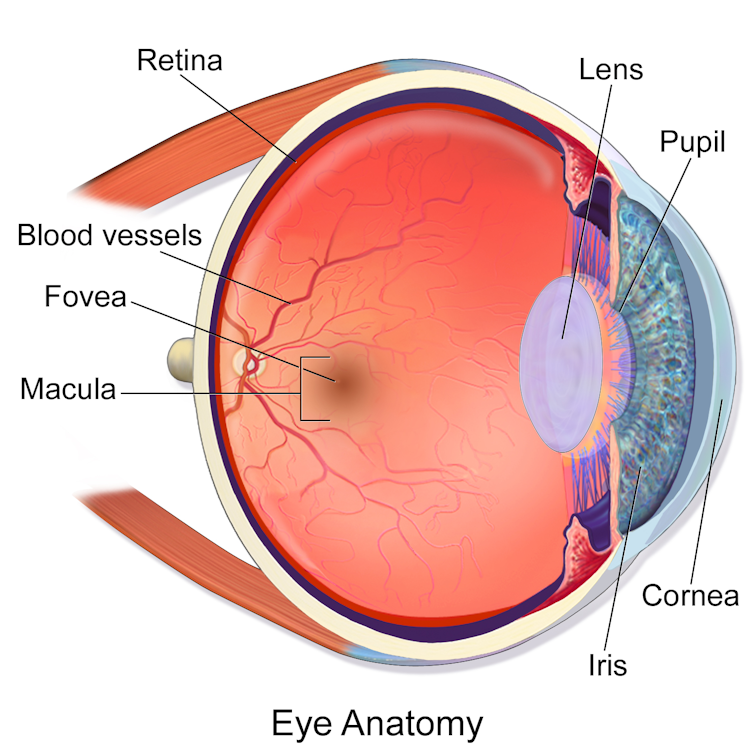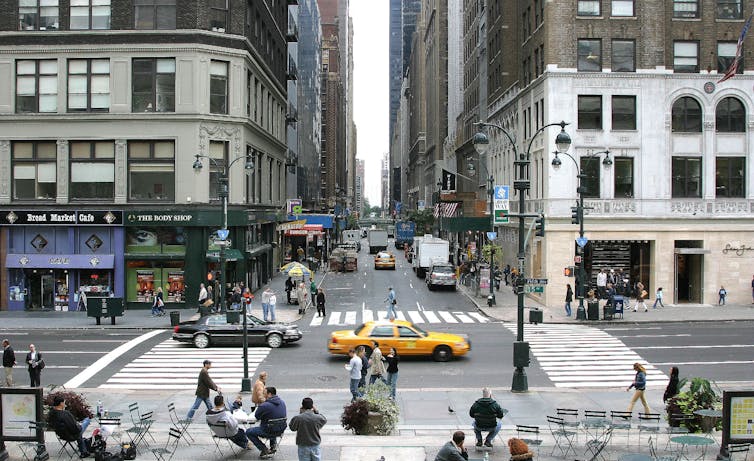How The Brain Registers Sight
Given that we come across the world through two small, flat retinae at the backs of our eyes, it seems remarkable that what each of us perceives is a seamless, 3-dimensional visual world.
The retinae respond to diverse wavelengths of lite from the world around us. But that's just the first role of the process. Our brains have to do a lot of work with all that raw data that comes in – stitching it all together, choosing what to concentrate on and what to ignore. It's the encephalon that constructs our visual world.
Neuroscience researchers and cognitive scientists take recently fabricated much progress investigating how this process works. My own research focuses on how humans construct the visual world past selecting what visual information to pay attention to and using visual memory to retain it over brusque periods of time. At that place's a lot more than simple sensory input that goes into building our perception of the visual world nosotros live inside.

Eyes as visual sensors
The retina is a sheet of cells at the back of each of our optics. Some of these cells, called photoreceptors, are sensitive to light. There are two main types: rods are sensitive to low-cal-dark differences and cones are sensitive to color.
These photoreceptors are most densely packed together in a pocket-sized area at the center of the retina chosen the fovea. Information technology corresponds to the center of our vision, where resolution is at its highest. Detail progressively decreases for distances further from the center of our visual field – that is, in the periphery (hence "peripheral vision").
As we expect around our environment, nosotros movement our optics. This enables us to orient the fovea toward what we're most interested in within the vicinity. These voluntary heart movements are called saccades and are made about three times a 2d.
Optics + encephalon = vision
Given that the optics are in constant motion, how does the picture of the world we have in our mind remain so apparently stable? Investigating this apparent discrepancy, neuroscientists have discovered that inputs from the eyes are suppressed during saccades, and then nosotros don't register the fast motion and paradigm blur that would otherwise occur. Furthermore, our brain corrects for movements of the optics using information from the center muscles that control their movement. Because the brain omits the data that comes in while the optics are moving, our visual world is perceived mostly during fixations, the short periods of time (approximately 200-300 milliseconds long) when the eyes are stationary. While reading for instance, our eyes are in motion only 10%-20% of the time.
During each fixation, we must select the visual information most relevant to performing the chore at hand. Nosotros have an power to attend to or focus on 1 or several sources of information while ignoring all the remainder, or at least reducing their significance. Researchers call this visual attention; they think it'south critical for helping us bind together or integrate elementary features (for example, colour, orientation) to form the perception of complete objects in the environment.

In other words, the theory holds that visual attending is our small window into the world. Information technology's from that express focus – both in space and attention – that our brains integrate visual information into coherent objects. For instance, when looking at a decorated city street, there are many potential sources of visual data to focus on. Merely using our visual attention we will simply select a pocket-size subset of this information – for example, the yellow blob coming toward us that forms into a taxi – at whatsoever i time.
Visual memory helps build the scene
It's selective processes such as visual attending that let the brain process of import data and discard what's not. What is or isn't of involvement will be adamant by your individual goals. For example, ane study showed that observers noticed a alter to an object in a virtual reality setting simply if that object was made task-relevant at the fourth dimension of the modify. For example, if they were told to most sort bricks by size, they were more than likely to notice changes in the bricks' dimensions than if they were only lifting them in the order they appeared.
To figure out what is or isn't important to the task at hand, an individual needs a way to retain some information across time. This is where visual memory comes in. Information technology's typically divided into short- and long-term flavors. The brusque-term version of visual retentiveness is most important in moment-to-moment construction and stabilization of the visual world.
Scientists used to call back visual curt-term memory represented the visual earth in particular, stitching together information from every stationary center fixation to build upwardly a detailed "motion-picture show in the head" of our surroundings.
Withal, more recent research has shown that observers typically don't notice relatively big changes to the visual environment when these changes are accompanied by, say, an centre movement, or some other interruption. This miracle is called change blindness.
In a related phenomenon called inattentional blindness, people frequently miss obvious events in the environment when engrossed in an unrelated task. For instance when required to count the number of passes of a basketball, people generally did not notice when a person in a gorilla suit crossed the court and walked right through the group of players.

Research into these phenomena and their associated mechanisms has shown that humans build up a more schematic version of the environment across heart fixations than was previously idea. This schematic version of the environment is typically known every bit scene gist. It contains conceptual data almost the scene'south basic category – is it natural, human-made, a cityscape? – and general layout, perhaps limited to a few objects and/or features. This schematic version of the environment is a far cry from the "flick in the head" scenario. But it'due south this schematic information that guides the states from one eye fixation to the side by side, during which more detailed data can be sampled.
Without the brain constantly computing as a visual processor, the visual information we receive through our eyes would remain a cluttered, jumpy mess. Corrective neurological mechanisms account for our eyes' movements. Visual memory and attention work together to let a fluid transition from one source of information to the next. In combination, these processes allow our brain to create our perception of a coherent, stable visual world.
How The Brain Registers Sight,
Source: https://theconversation.com/how-do-our-brains-reconstruct-the-visual-world-49276
Posted by: muiaboold.blogspot.com


0 Response to "How The Brain Registers Sight"
Post a Comment